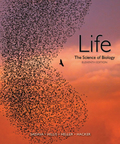
To review:
The most and the least important genera of coral that contribute to the reef-building, and the reason behind their importance and unimportance, based on the data provided in Table 1.
Given:
Different genera of corals contribute different amounts of calcium carbonate (CaCO3) to the reefs. The rates of calcium deposition by different coral genera are represented in Table 1.
Table 1: Different genera of corals
| Coral genus | Average reef rugosity | Approximate mean rate of calcification (Kg CaCO3/m2/yr) |
| Orbicella | 1.87 | 13.80 |
| Acropora | 3.33 | 22.30 |
| Porites | 1.49 | 6.12 |
| Agaricia | 1.52 | 2.43 |
Introduction:
The corals are the foundation and the ecosystem engineering species. They are capable of building reefs, which act as the shelter for themselves as well for several other species. The reefs are formed by deposition of the calcium carbonate shells on the death of a coral. The rate of deposition of calcium carbonate depends upon the type of species.
More amount of calcium carbonate is deposited by the slow-growing corals. The corals, especially, slow-growing corals are very sensitive to the pollution. The loss of the corals results in the loss of a massive habitat.
Want to see the full answer?
Check out a sample textbook solution
Chapter 56 Solutions
EBK LIFE: THE SCIENCE OF BIOLOGY
- What symbolic and cultural behaviors are evident in the archaeological record and associated with Neandertals and anatomically modern humans in Europe beginning around 35,000 yBP (during the Upper Paleolithic)?arrow_forwardDescribe three cranial and postcranial features of Neanderthals skeletons that are likely adaptation to the cold climates of Upper Pleistocene Europe and explain how they are adaptations to a cold climate.arrow_forwardBiology Questionarrow_forward
- ✓ Details Draw a protein that is embedded in a membrane (a transmembrane protein), label the lipid bilayer and the protein. Identify the areas of the lipid bilayer that are hydrophobic and hydrophilic. Draw a membrane with two transporters: a proton pump transporter that uses ATP to generate a proton gradient, and a second transporter that moves glucose by secondary active transport (cartoon-like is ok). It will be important to show protons moving in the correct direction, and that the transporter that is powered by secondary active transport is logically related to the proton pump.arrow_forwarddrawing chemical structure of ATP. please draw in and label whats asked. Thank you.arrow_forwardOutline the negative feedback loop that allows us to maintain a healthy water concentration in our blood. You may use diagram if you wisharrow_forward
- Give examples of fat soluble and non-fat soluble hormonesarrow_forwardJust click view full document and register so you can see the whole document. how do i access this. following from the previous question; https://www.bartleby.com/questions-and-answers/hi-hi-with-this-unit-assessment-psy4406-tp4-report-assessment-material-case-stydu-ms-alecia-moore.-o/5e09906a-5101-4297-a8f7-49449b0bb5a7. on Google this image comes up and i have signed/ payed for the service and unable to access the full document. are you able to copy and past to this response. please see the screenshot from google page. unfortunality its not allowing me attch the image can you please show me the mathmetic calculation/ workout for the reult sectionarrow_forwardIn tabular form, differentiate between reversible and irreversible cell injury.arrow_forward
 Biology Today and Tomorrow without Physiology (Mi...BiologyISBN:9781305117396Author:Cecie Starr, Christine Evers, Lisa StarrPublisher:Cengage Learning
Biology Today and Tomorrow without Physiology (Mi...BiologyISBN:9781305117396Author:Cecie Starr, Christine Evers, Lisa StarrPublisher:Cengage Learning Biology (MindTap Course List)BiologyISBN:9781337392938Author:Eldra Solomon, Charles Martin, Diana W. Martin, Linda R. BergPublisher:Cengage Learning
Biology (MindTap Course List)BiologyISBN:9781337392938Author:Eldra Solomon, Charles Martin, Diana W. Martin, Linda R. BergPublisher:Cengage Learning
 Concepts of BiologyBiologyISBN:9781938168116Author:Samantha Fowler, Rebecca Roush, James WisePublisher:OpenStax College
Concepts of BiologyBiologyISBN:9781938168116Author:Samantha Fowler, Rebecca Roush, James WisePublisher:OpenStax College





